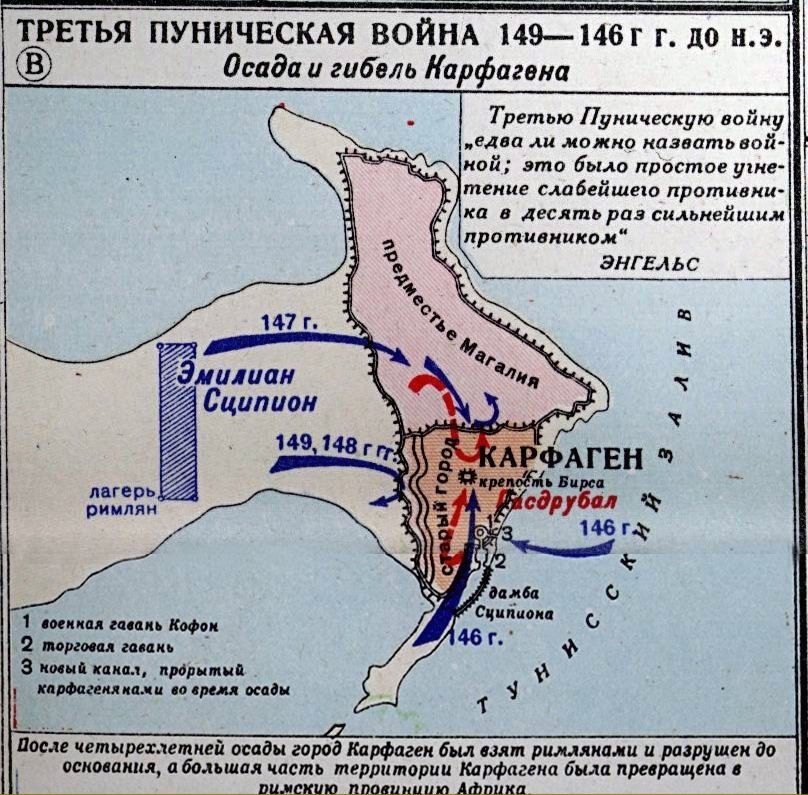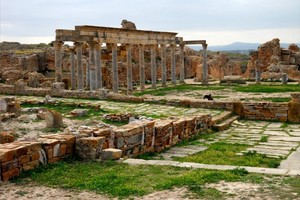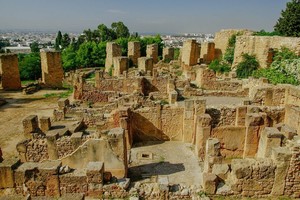Third Punic War
The Punic Wars were a series of three wars fought intermittently between Ancient Rome (Roman Republic) and Carthage (a former Phoenician colony in North Africa that later became an independent state). Rome emerged victorious, seizing control of the entire Western Mediterranean and ultimately destroying Carthage.
The Third Punic War (late 149 – spring 146 BCE) was the final of the Punic Wars, resulting in the complete destruction of Carthage.
Punics or Phoenicians (punicus in Latin) was the Latin term for the Phoenicians living in North Africa, particularly the inhabitants of Carthage (a former Phoenician colony). They were also known by this name because they traded in a mollusk that produced a purple dye when processed.
The Balance of Power Before the War
Reasons The causes of the Third Punic War from Carthage's perspective included a thirst for revenge, the desire to restore its former power, and the need to defend its independence from Rome. From Rome's perspective, there was a fear that Carthage might regain its strength, as well as a desire to eliminate a major trade rival completely.
Carthaginian generals Hasdrubal Boetharch (who commanded the defense of Carthage).
Roman generals Publius Cornelius Scipio Aemilianus Africanus; Lucius Marcius Censorinus (a Roman naval commander – fleet prefect).
 Map of the military campaign of the 3rd Punic War
Map of the military campaign of the 3rd Punic War
The Course of the War
The trigger for the start of the Third Punic War was Carthage's armed response to the harassment by the king of Numidia and Rome’s ally, Masinissa. Complaints about his actions to Rome yielded no results, leading Carthage to engage in military actions against him, which Rome immediately used as a pretext to start a new war.
In 149 BCE, a Roman army commanded by consuls Manius Manilius and Lucius Marcius Censorinus landed in Africa. The Carthaginians, not wanting war, attempted to negotiate peace with the consuls, but were deceived and ultimately began armed resistance against the Roman forces, led by Hasdrubal Boetharch. The Romans surrounded the city and laid siege to it. Initially, the Romans attempted to take the city by storm, but after failing, they switched to a prolonged siege.
In 147 BCE, a new commander of the Roman forces, consul Publius Cornelius Scipio Aemilianus, son of Aemilius Paulus and adopted son of Scipio Africanus, arrived from Rome to Africa. He conducted the siege more energetically and competently than his predecessors.
Finally, in the spring of 146 BCE, the Romans managed to capture the city, except for Byrsa (a fortified citadel in the city center). Street fighting continued for some time afterward, but eventually, on the seventh day of fighting, the defenders of Byrsa surrendered, except for Hasdrubal and some Roman deserters who locked themselves in a temple, where they perished rather than fall into Roman hands, all except Hasdrubal, who surrendered. The remaining captured inhabitants of Carthage were sold into slavery. Ultimately, the Romans looted the city and destroyed it, plowing over the site where it stood, and sowing salt into the ground. The reconstruction of the city on this site was forbidden under the threat of a curse.
The territories of the former Carthage became a Roman province, with its capital in the city of Utica (located northwest of Carthage, at the mouth of the Bagrada River, known today as the Medjerda River in Tunisia and partly in Algeria, on a promontory jutting into the sea). Thus ended the Third Punic War.
Related topics
Roman Republic, First Punic War, Second Punic War, Punics
Literature
Ancient authors:
1. Polybius. Universal History.
2. Titus Livy. Roman history from the founding of the city
3. Appian of Alexandria. Roman history
4. Plutarch. Comparative biographies
Contemporary authors:
1. Revyako K. K. Punic wars. Minsk: Universitetskoe Publ., 1988, 272 p. (in Russian)
2. Rodionov E. Punicheskie voyny [Punic Wars]. St. Petersburg: SPBU Publishing House, 2005. (Res militaris)
3. Bagnall, Nigel. The Punic Wars: Rome, Carthage and the Struggle for the Mediterranean. — London : Pimlico, 1999
4. Punic Politics, Economy, and Alliances, 218–201 // A Companion to the Punic Wars (неопр.) / Hoyos, Dexter. — Oxford: Wiley-Blackwell, 2011 г.
5. Shifman I. I. Carthage. Saint Petersburg: Saint Petersburg University Press. 2006
6. Delbrueck H. The history of military art in the framework of political history. — Translated from German-Vol. 1 "The Ancient world". - Moscow, 1936.
7. Eliseev M. B. The Second Punic War. - Moscow: Veche, 2018. - 480 p.: ill. - Series "Antique world".
8. Mashkin N. A. The last century of Punic Carthage / / VDI. - 1949. - No. 2.
9. Herbert William Park. Greek mercenaries. Dogs of War of ancient Greece / Translated from English by L. A. Igorevsky. - Moscow: ZAO "Tsentrpoligraf", 2013. - 288 p.
10. Warmington B.-H. Carthage. — L., 1960.
11. Mayak I. L. Sotsial'no-politicheskaya borba italiyskikh obshchestvov v period Gannibalovoy voyny [Socio-political struggle of Italian communities during the Hannibal War].
12. Shifman I. S. Vozrozhdenie karfagenskoi derzhavy [The Emergence of the Carthaginian Power].
13. Elnitsky L. A. The emergence and development of slavery in Rome in the VIII-III centuries BC-Moscow, 1964.




